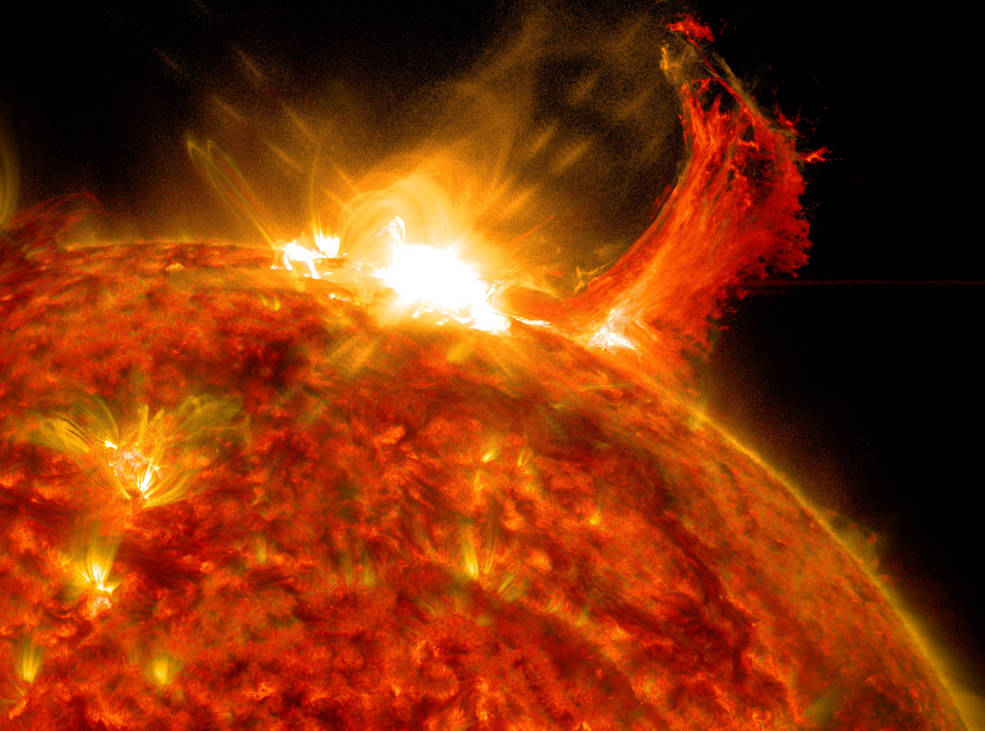What You Need to Know About the Solar Storm That Is Coming

The Sun is the source of life on Earth, but it can also pose a threat to our planet. The Sun is constantly emitting streams of charged particles, known as the solar wind, that can interact with Earth's magnetic field and cause disturbances in our atmosphere. Sometimes, the Sun produces powerful eruptions of plasma and magnetic fields, known as coronal mass ejections or CMEs, that can travel through space and hit Earth, causing geomagnetic storms. These storms can affect satellites, power grids, communication systems, and even human health. NASA has warned that Earth is continuously experiencing solar storms and that there might be another storm approaching today, one of these CMEs might be on a collision course with our planet.
How Do Solar Storms Happen?
The Sun is a huge ball of plasma, or ionized gas, that is held together by its own gravity. The Sun has a complex magnetic field that changes over time, creating regions of different temperatures and pressures on its surface. These regions are called sunspots, and they are the sites of intense solar activity. Sunspots can produce flares, which are sudden bursts of radiation and energy, and CMEs, which are massive explosions of plasma and magnetic fields that can reach speeds of millions of kilometers per hour.
The Sun goes through cycles of activity that last about 11 years, during which the number and size of sunspots vary. The Sun is currently in a more active phase of its cycle, which means that it has more sunspots and more frequent CMEs. The last major solar storm that hit Earth was in 1859, known as the Carrington Event. It caused fires on telegraph wires and auroras that were visible as far south as Cuba and Hawaii.
What Are the Effects of Solar Storms on Earth?
%20(1).jpeg)
When a CME reaches Earth, it can interact with Earth's magnetic field, which acts as a shield against the solar wind. Depending on the direction and strength of the CME's magnetic field, it can either bounce off or penetrate Earth's magnetic field, causing a geomagnetic storm. A geomagnetic storm can have various effects on Earth, such as:
- Radio blackouts: The CME can interfere with the ionosphere, a layer of the atmosphere that reflects radio waves, causing disruptions in radio communication, navigation, and broadcasting.
- GPS disruptions: The CME can cause errors in the signals from the satellites that provide GPS services, affecting the accuracy and reliability of navigation and mapping.
- Geomagnetic disturbances: The CME can induce electric currents in the ground and in long metal structures, such as power lines and pipelines, causing damage to transformers, generators, and other equipment. This can lead to power outages, voltage fluctuations, and corrosion .
- Radiation exposure: The CME can increase the levels of cosmic rays and solar energetic particles, which are harmful forms of radiation, in Earth's magnetosphere and atmosphere. This can pose a risk for astronauts, airplane passengers, and polar residents, who are more exposed to these particles. Exposure to high doses of radiation can cause health problems, such as cancer, cataracts, and DNA damage .
What Are the Benefits of Solar Storms on Earth?
.jpeg)
.jpeg)
Solar storms are not all bad, though. They can also create beautiful auroras that might be visible in the night sky, depending on the location and weather conditions. Auroras are caused by charged particles from the Sun colliding with atoms and molecules in Earth's atmosphere, creating colorful lights. The most common colors are green and red, but other colors, such as blue, purple, and yellow, can also appear. Auroras are usually seen near the poles, where the magnetic field lines are more vertical, but they can also be seen at lower latitudes during strong solar storms.
How Can We Prepare for Solar Storms?
Solar storms are unpredictable and hard to avoid, but we can take some measures to reduce their impact and protect ourselves. Some of the things we can do are:
- Stay informed: We can monitor the space weather forecasts and alerts from NASA, NOAA, and other agencies, and follow their recommendations and warnings .
- Protect our devices: We can unplug our electronic devices and appliances, and use surge protectors, to prevent damage from power surges and fluctuations. We can also backup our data and use offline modes for our phones and computers, to avoid losing information and connectivity.
- Avoid travel: We can avoid flying, driving, or sailing during solar storms, to reduce the risk of navigation errors and radiation exposure. We can also stay indoors and away from windows, to shield ourselves from the harmful particles.
- Enjoy the view: We can look for a dark and clear spot to watch the auroras, if they are visible in our area. We can also take pictures and videos of the spectacle, and share them with our friends and family.
Conclusion
Solar storms are natural phenomena that can have both positive and negative effects on Earth. They are caused by the Sun's activity, which produces powerful eruptions of plasma and magnetic fields that can hit Earth and cause geomagnetic storms. These storms can affect satellites, power grids, communication systems, and human health, but they can also create beautiful auroras that can be seen in the night sky. We can prepare for solar storms by staying informed, protecting our devices, avoiding travel, and enjoying the view. Solar storms are a reminder of the dynamic and fascinating relationship between the Sun and Earth, and the wonders of the universe.